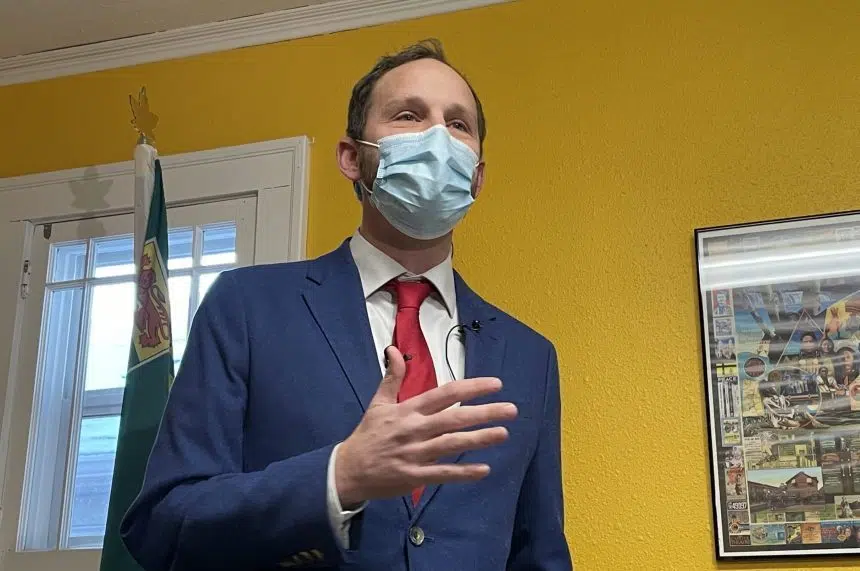Thousands on foot listened to rabble-rousing speeches at Queen’s Park before marching north to the trucks in Yorkville
Author of the article :Tom Blackwell
Publishing date: Feb 05, 2022 •
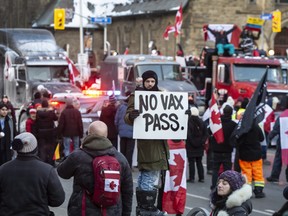
Article content
Toronto police succeeded in one of their goals Saturday, keeping a truck convoy protesting COVID vaccine mandates and lockdowns away from the provincial legislature and several downtown hospitals.
Whether that’s something to celebrate or not remains to be seen.
The service failed to stop the demonstration from causing major disruption elsewhere, as several huge dump trucks, tractor trailers and thousands of protesters clogged a major intersection.
And the driver of at least one of those vehicles vowed to stay put for days or more until governments rescind COVID vaccine mandates.
With his dump truck parked a few feet from the police lines outside the Royal Ontario Museum, driver Dejam Radovic said he will stay there “as long as it takes.”
“I have to make money but I’m not going to go anywhere. You know, I would sacrifice even one year of my life,” he said from the cab of his vehicle. “Nothing can stop us. Nothing can push us. We are not afraid.”
With the route into Queen’s Park – Ontario’s legislative buildings – blocked off by police, a stream of “Freedom Convoy” vehicles came to a halt and produced instant gridlock just to the north of the area.
Rigs filled the corner of Bloor Street and Avenue Road in the heart of the city’s tony Yorkville neighbourhood, with the ROM at one corner of the intersection.
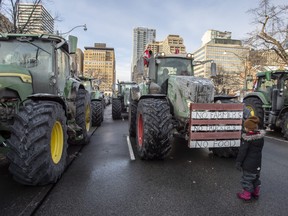
A backlog of protest automobiles stretched east and west for several blocks on Bloor and north on Avenue as demonstrators streamed around them, effectively shutting down two major thoroughfares. Some of the protesters stopped next to luxury-goods stores like Gucci and Cartier, making for an odd juxtaposition.
South of where police had barricaded streets, more protest vehicles brought traffic to a standstill on busy Queen Street West. Unlike the area around Queen’s Park and the five hospitals that line University Avenue, the neighbourhoods where the honking protesters wound up are packed with condominiums and other homes.

Residents of Ottawa, where such commotion has been going on now for a week, have grown increasingly angry at the imposition, some of them even launching a class-action lawsuit against the protesters.
Toronto police charged a 22-year-old man with administering a noxious substance, assault with a weapon and public mischief for allegedly setting off a smoke bomb near Queen’s Park. But the protest was largely peaceful, as an almost-festive mood prevailed at the Bloor and Avenue intersection.

Toronto police barricade streets in advance of truckers' protest, aiming for 'minimal disruption'

‘An occupation’: GoFundMe pulls plug on fundraiser for convoy protesters
People danced to recorded music, waved flags and climbed on top of the big trucks parked in the middle of the road.
Despite taking place near the seat of Ontario’s government and the fact that most vaccine mandates have been imposed by the provinces or private business, much of their anger was directed at Prime Minister Justin Trudeau.
Flags and signs that simply said F— Trudeau were a popular item. One of the speakers at the start of the demonstration said the prime minister is not even Canadian.
“We should strip him of his passport and get him the hell out of Canada,” the man said to cheers from a crowd that braved temperatures hovering around minus 10 degrees.

Speakers and protesters evoked human-rights legislation and chanted “freedom,” depicting as autocratic policies that require vaccination to work for certain employers and to access such services as restaurants and gyms.
Yiqi Zhang, 28, said he spent a week in North Korea a couple of years ago and is worried Canada is heading in the same direction.
“If it can happen there, it can happen here. And it is happening here,” said the software developer. “I think vaccines are great, but when the government says you have to do something … it’s immoral.”
His white German Shepherd, Lucy, was wearing a T-Shirt that said “mandate snacks, not the vax.”
I think vaccines are great, but when the government says you have to do something … it’s immoralPROTESTER YIQI ZHANG
Jason Fleming, whose tractor was also stopped a car-length from a line of police officers, said he had been a cross-border trucker and was unemployed for a month when the federal government insisted that such drivers had to be vaccinated. He had to re-certify his truck for domestic routes. Asked what he wants out of the demonstration, Fleming said “our freedoms back. Exactly that.”
Getting vaccinated “should be my choice to make,” he said.
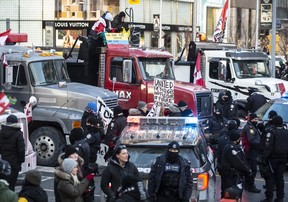
The protest effectively began Friday afternoon when hulking farm tractors parked near the ROM, blocked from driving any further.
The barricades around Queen’s Park were part of a law-enforcement effort designed to stave off a long-term occupation of the city’s core and safeguard the five major hospitals that lie just south of the legislature on University Avenue.
Civic leaders vowed to stop them from repeating what happened in the nation’s capital, where tractor-trailers and protesters have clogged streets around Parliament Hill and filled the core with honking.
“We all want to do what we can to avoid the situation we’re seeing in Ottawa,” said Mayor John Tory Friday. “If anyone is planning to come here for a protest that is not peaceful and is not respectful, I would urge you on behalf of all Toronto residences and businesses, to please stay home.”
t
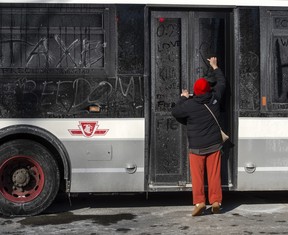
By Friday afternoon, police had used parked buses to block off the stretch of University Avenue known as hospital row, home to some of Canada’s largest health-care centres. Previous anti-lockdown and anti-vaccine protests in Toronto and elsewhere have targeted hospitals , in some cases impeding access to the facilities. Some health-care workers held their own counter-protest Saturday.
Tory, meanwhile, appeared to take an indirect dig at the protesters, citing the fact that over 90 per cent of eligible Toronto residents have received at least one dose of vaccine and 60 per cent are triple vaccinated.
“What great demonstrations of the unity of the people of this city, of teamwork, of concern for each other,” he said.
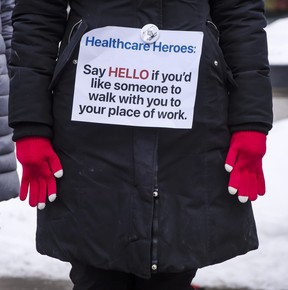
Kerrisa Wilson, CP24 Web Content Writer
Bryann Aguilar, CP24 Web Content Writer
Published Saturday, February 5, 2022
The sound of honking trucks echoed through the streets of downtown Toronto Saturday as a large crowd of protesters descended upon the city to demand the end of COVID-19 restrictions.
The protest, organized by the "Freedom Convoy," started at noon at Queen's Park, with protesters carrying signs and flags and chanting against COVID-19 vaccine mandates, including proof of vaccination in certain indoor settings.
Several people who attended the protest told CP24 that they don't want vaccines, masks and other public health rules that are aimed at curbing the spread of COVID-19 to be forced on them. They believe that all levels of government are not handling the pandemic correctly.
RELATED STORIES
This is what Toronto's anti-mandate protests looks like
Ottawa, other cities act to rein in escalating protests against COVID-19 measures
Shortly before 2:30 p.m., police said a 22-year-old male protester was arrested at the north side of Queen's Park.
The man was arrested for assault with a weapon, administering a noxious substance (smoke bomb), and public mischief, police said.
No other arrests have been reported.
The protest later moved north at the intersection of Bloor Street West and Avenue Road, where a large volume of trucks and demonstrators blocked the road.

The blockade slowed down Peel paramedics, police said, warning protesters to let emergency vehicles through.
"This is unacceptable and will not be tolerated," police tweeted. There are also two fire stations in that area and police said they were concerned that the fire trucks may not be able to leave if needed.
Later in the afternoon, a CP24 crew saw several smoke bombs set off at that intersection but there was no immediate word on whether someone was arrested.
In an update Saturday afternoon, Toronto police Staff Supt. Lauren Pogue said the protest has relatively been "peaceful."
"We still do have a very large Toronto police presence in the core and this is to ensure public safety, that our community has unimpeded emergency vehicle access, and also to minimize disruption to the residents and businesses in the area," Pogue told CP24.
"Our plans are fluid. We're dynamic. I can tell you that we're there to ensure that everyone remains safe and that and that includes our police officers who are on the ground."

Widespread traffic delays in the downtown area were also reported Saturday as a result of the protest and the number of road closures.
It is not known when roads will reopen.
"We're assessing things as we go and we'll certainly look to open up things when it's safe to do so," Pogue said.
She added that there have been no issues reported at Hospital Row, saying hospital workers, patients and others trying to access the facilities have been able to do so.
Ahead of the protest, the Ontario Trucking Association (OTA) released a statement saying they do not support and disapprove protests on public roadways, highways and bridges.
The OTA said the majority of Ontario truckers are vaccinated.
"While some Canadians are at Queen's Park today to voice their displeasure over this mandate, it appears that most protestors have no connection to the trucking industry and have separate grievances beyond the cross-border vaccine requirements," OTA said.
"As these protests unfold, OTA asks the public to be aware that many of the people you see and hear in media reports do not have a connection to the trucking industry and do not represent the view of the Ontario Trucking Association or its members."
City officials and police learned about the planned protest earlier this week, prompting them to prepare for similar disruptions brought on from the ongoing protest in Ottawa.

On Friday police started to close roads in the downtown core and have advised residents to expect a large police presence in the area this weekend.
“The service is required to facilitate peaceful demonstrations,” Police Chief James Ramer told reporters at a briefing Friday. “This will be balanced by our priority to ensure public safety to protect hospitals and infrastructure and the city's emergency response needs.”
Ramer said that large vehicles will not be allowed to congregate around Queen’s Park and that the demonstrators will be encouraged to go to staging areas and then travel to the provincial legislature by foot if they want to protest there.
He added that anyone who tries to block access to nearby hospitals will be “subject to strict enforcement.”
Some hospital staff were advised on Thursday to avoid wearing any scrubs or clothing identifying them as health-care workers when they come into work this weekend to avoid being blocked or harassed.
Women’s College Hospital rescheduled some appointments and closed its COVID-19 assessment Centre early on Friday and altogether over the weekend “out of an abundance of caution.”
HEALTH-CARE WORKERS STAGE COUNTER PROTEST
In response to the demonstration, a group of health-care workers is planning a counter protest downtown to ensure protesters do not interfere with anyone trying to receive health-care services.
"The goal is to let Torontonians know that we want to ensure that they will have unfettered access to hospitals in downtown, to community-based clinics in downtown, and to let our colleagues who are working in the hospitals today know that they should feel safe and secure walking the streets dressed however they want to, in their white coats," Dr. Philip Berger, organizer of the Access to Care rally, told CP24.

City Councillor Joe Cressy also attended the health-care workers' protest to show his support.
"While there are people protesting with a different message, the vast vast majority of Torontonians have done the right thing and continue to do the right thing and these health-care workers help make it happen," Cressy told CP24.
Mayor John Tory urged anyone who does not plan to protest peacefully to “stay home.”
“If anyone is planning to come here for a protest that is not peaceful, and that is not respectful, I would urge you on behalf of all Toronto residents and businesses to please stay home. Peaceful and respectful is the way we do things here,” Tory said at a city press briefing on Friday.
Last weekend, thousands of protesters and truckers, many of whom drove from the west coast, gathered in the nation’s capital to rally against COVID-19 mandates.
The demonstration, which some have described as an “occupation,” is now in its ninth day, resulting in ongoing traffic gridlock and honking vehicles.
Ottawa police reported significant disruptions due to the convoy, including vandalism, harassment, expressions of hate and violence and ongoing obstruction of many services.
On Thursday evening, federal Public Safety Minister Marco Mendicino said the RCMP approved Ottawa Mayor Jim Watson's request for the RCMP to support city police in monitoring the protest.
Local protests have also broke out in southern Alberta, Quebec City and Winnipeg.
-With files from CP24’s Joshua Freeman
Navigator, with tagline 'When you can't afford to lose,' is
working on Ottawa police communications
In the moments before the Ottawa police's Friday morning briefing on the ongoing anti-vaccine mandate protest on Parliament Hill, officers — both in uniform and plain clothes — and media alike awaited the arrival of the chief and deputy chiefs.
Meanwhile, a few folks were passing around a news release on tougher police measures coming in the days ahead, including one man who was not with the police services, but with the chief's office, CBC was told.
That man was Matthew Barnes, a senior consultant for Navigator — an elite and expensive crisis management firm.
Police chief Peter Sloly's office confirmed by email that Navigator was hired last weekend to "assist the Ottawa Police Service and Ottawa Police Services Board with communication/community engagement support on the first weekend of the demonstrations."
The full costs of the services aren't known yet, but according to the statement, taxpayers are paying Navigator on what's being described as a "fee-for-service basis," with "an upside limit" of $50,000 to $75,000.
There was no competitive bid for the communications work because, according to police, the contract is within the service's sole-source guidelines for special events.
Whether the strategy is working is unclear.
According to CBC sources, Sloly didn't strictly follow his speaking notes during Wednesday's news conference, when he suggested that it might be necessary to call in the military to cover the protest, and that policing alone may not be enough to bring the demonstrations to an end.
Police did not comment on whether Sloly went off-script on Wednesday.

'High-stakes communications strategist'
With the tagline, "When you can't afford to lose," Navigator describes itself as "Canada's leading high-stakes strategic advisory and communications firm."
It was founded more than 20 years ago and its executive chairman, Jaime Watt, was a Progressive Conservative strategist who worked with former premier Mike Harris, helping him launch his "Common Sense Revolution." He's represented high-profile clients — including, briefly, former CBC host Jian Ghomeshi.
According to the bio on the company's website, Watt is "widely regarded as Canada's leading high stakes communications strategist, he is a trusted advisor to boards of directors, business and professional leaders as well as political leaders at all three levels of government across Canada."
Navigator opened an office in Ottawa last March, according to a news release at the time, led by Graham Fox and Barnes.
Before joining Navigator, Barnes was a senior communications manager to Finance Minister Chrystia Freeland and worked for her predecessor Bill Morneau.
Fox was formerly the CEO of think tank Institute for Research on Public Policy, and previously worked in government relations for the clients of law firm Fraser Milner Casgrain (now Dentons).


